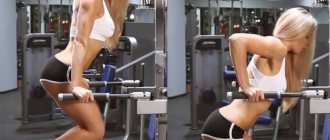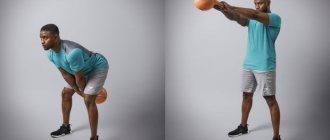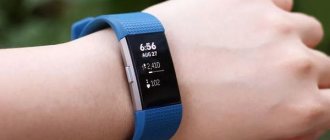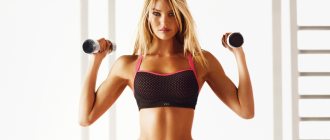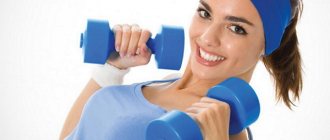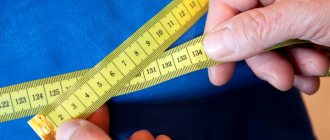What do you need to remember when training arm strength?
All exercises are divided into 2 categories - basic and isolated.
Basic exercises involve more than one muscle group and require significant energy expenditure.
Do not perform exercises with movements that are unnatural for the muscle groups being worked. Otherwise, you risk getting injury rather than progress.
Testosterone production
The most optimal combination of exercises to increase arm strength with training large muscle groups:
There are many combinations, but the most popular are the following:
- chest + triceps;
- back + biceps;
- legs + shoulders, forearms.
Why such a scheme? The fact is that when training large muscle groups, the largest amount of testosterone is produced - a growth hormone that gives impetus to hypertrophy. The larger the group, the more testosterone.
You can pump biceps together with triceps or use other combinations, but in this case the process will slow down significantly.
Warm-up and equipment
Any workout should start with a warm-up. It is necessary to warm up the joint and increase blood flow to the muscle fibers.
Don’t forget about equipment: it is recommended to wear bandages, gloves and restraints during training. All this will protect you from injuries, calluses, and wounds on your hands.
Training complexes for hands
What to do with all these exercises for arm strength? There are countless training complexes. Let's give a couple of examples.
Complex for deltoids and triceps:
| Description of the exercise | |
| Standing barbell press - deltas | The barbell is taken from the racks and held in front of the chest at shoulder width. Without turning on the legs, the projectile is squeezed upward. |
| Dumbbell swings to the sides - deltas | Starting position – arms with dumbbells are lowered down. Raise your arms to a level just above your shoulders. After overcoming the line of deltas, the hands are slightly turned so that the little fingers are at the top. |
| Close Grip Bench Press – Triceps | Grip – 10-20 cm. The barbell is taken from the racks, lowered onto the chest and squeezed up. |
| Dumbbell Elbow Extension – Triceps | Starting position – the body and shoulder are parallel to the floor, the forearms and hands are perpendicular. The arm at the elbow is extended all the way, lingering at the climax for 1-2 seconds. |
Complex for biceps, forearms and hands:
| Exercise and working muscle groups | Description of the exercise |
| Barbell curls - biceps | Starting position – hands with a barbell (underhand grip) are lowered down. Using the forces of the biceps, the projectile is brought to the shoulders and then slowly lowered. |
| Seated Hammer Curls – Biceps | Starting position – arms (turned towards the body) with dumbbells lowered down. Using the forces of the biceps, the projectiles are brought to the shoulders and then slowly lowered. In addition to developing biceps, the exercise helps to increase strength in the bench press. |
| Bend the barbell with an overhand grip - forearms | Similar to the first exercise (biceps), but with the opposite grip. |
| Holding a barbell while standing – hands (grip) | Starting position – arms with the barbell are lowered down, in front of the legs. You need to stand there for as long as possible. It's better to use a thick bar. Not every gym has such equipment, so you can wrap the bar with a towel - this will significantly increase the load on your hands, removing it from your back and legs. |
The number of approaches of each exercise to increase arm strength is within 2-3 (not counting warm-up ones). The number of repetitions is 5-10 (the fewer repetitions, the greater the focus on developing strength).
Hand training
Training these parts of the upper limbs in gyms is not given enough attention, considering it a waste of time. However, strengthening your hands is excellent for injury prevention and increases strength.
With expander
An expander is a simple and universal tool for pumping up the muscles of the hands. There are many variations of these simulators: in the form of handles, fruit shapes or regular rings. The principle is the same everywhere – pressing movements with the fingers.
Beginners are recommended to start with spring expanders, since the resistance in them is much lower than in rubber circles.
To achieve the effect, start with 10-15 repetitions per arm, 5 sets. After your hands get used to it, increase the number of approaches by 1, the number of repetitions by 2–3.
On gymnastic equipment
The role of gymnastic equipment is:
Pull-ups are a general developmental exercise for the muscles of the back and arms. Together with ring exercises, they improve the strength of grasping movements and help strengthen the wrist area.
If you have a barbell, place it just below hip height behind you. Take it in your hands so that it rests on your fingertips, and your hands are straight and relaxed. Then begin to bend/extend your hands, rolling the bar from your fingers to the underside of your palm. For beginners, the optimal repetition range is 10–15, for more advanced athletes – 15–25.
A jump rope will help develop rotational movement and increase the mobility of the limbs being worked on. For variety, you can try both the classic version and backward rotations, cross-on-cross or double, when a strong rotational movement is performed and the athlete jumps through 2 rotations rather than 1.
Exercises for different parts of the hands
Let's look at the basic exercises for various muscle groups of the arms. Let’s “walk” through the arms from bottom to top – from the hands to the deltoids.
Hand training
You can train your hands both in the gym and at home, using various techniques and equipment. To begin with, let’s talk about how to increase your grip strength by working with an expander and gymnastic equipment.
With expander
Using a rubber ring or spring implement is a classic scheme for increasing grip strength. Examples of exercises:
- squeezing and unclenching the projectile - as an option, you can work with only two or three fingers or lean on the static - hold the compressed expander for a while;
- twisting the rubber in a figure eight - excellent for developing finger strength;
- stretching rubber bands with your fingers - the intensity increases due to an increase in the number of elements;
- squeezing a tennis ball.
The load is limited by the number of repetitions, the degree of tightness of the projectile and time. You can train purposefully, performing several sets to the limit, or from time to time throughout the day. The expander is convenient because it takes up minimal space, so you can work with it at any time and anywhere.
On gymnastic equipment
Gymnastic apparatus or their imitation will help you develop an unusually strong grip.
Examples of exercises:
- Hanging on the horizontal bar. There are many ways to diversify the exercise - here are the options: hanging on two hands with weights; hanging on one arm for a while; hanging on several fingers; hanging from a thick and/or rotating bar.
- Separately, it is worth mentioning the hanging on the towels. Unlike the horizontal bar, the vertical grip uses the thumb to the maximum. This is the exercise that Paul Wade recommends primarily in his famous book “The Training Zone.” Anyone who can hang on a thick towel by one hand for a minute can safely challenge the strongest armlifters.
- . There are also a large number of variations - light, with additional weight, with different positions of the hands, for speed, performing static movements (analogous to hanging on towels), etc.
Forearm workout
There are three main exercises that develop powerful forearms:
- Dumbbell Wrist Curls (underhand grip): The exercise is aimed at developing the inner part of the forearm.
- Dumbbell wrist curls (overhand grip): an option designed for the outer zone.
- Overhand Dumbbell or Barbell Curls: This exercise also helps strengthen and tone the outer forearms.
Biceps workout
The favorite muscles of most gym goers are trained in different ways. Classic exercises include:
- barbell curls (straight bar);
- barbell curls (EZ bar);
- curls with a barbell on a Scott bench;
- curling arms with dumbbells with an underhand grip, with supination of the hands;
- hammer curls with dumbbells - palms facing the body.
All of these options involve the biceps muscles, but each differs in certain nuances. By performing all the variations, you will achieve comprehensive development of your biceps. When working “for strength”, resorting to diversity is not necessary. There are many athletes who have developed enormous power using 1-2 exercises.
Triceps workout
Most of the arm is “given” to the triceps muscle. Therefore, those who strive to increase volume should first of all focus on this muscle group, and not on the biceps. Basic exercises:
- bench press with a narrow grip - the narrower the grip, the more the triceps are loaded;
- French press - extension of the arms (with a barbell or dumbbells) at the elbows; the traditional position is lying down, but can also be done while sitting;
- extension of the arms downwards on a block simulator - it is best to use ropes rather than a handle.
Delt training
We owe the powerful V-shaped appearance to the developed deltoid muscles. The basis:
- standing or sitting barbell press - aimed at the front deltas and gaining enormous strength (the standing press was a part of weightlifting triathlon for a long time, until the exercise was removed from the competition complex);
- overhead barbell press - aimed at developing the middle fascicles;
- swing dumbbells to the sides while standing: target - medium bunches;
- swinging dumbbells in front of you - develops the frontal zone of the deltas;
- tilted dumbbell swings - designed to train the rear deltas.
Exercises for arm muscles
For the comprehensive development of arm muscle strength, you can combine various types of exercises and sports equipment.
With dumbbells
Take dumbbells with your arms straight at your sides along your torso. This is the starting position. Contract your biceps by raising your arms with dumbbells to your chest and lower them to the starting position. In bodybuilding, this exercise is called the “hammer”.
An alternative option is to sit with your back straight and your arms straight down, holding the dumbbells. Perform bicep curls with each arm in turn, pausing at the top for a second and slowly lowering your arms to the starting position.
Triceps
Take a dumbbell in your hands and lift it, placing it behind your head and straightening your limbs. Extend your arms, bringing the projectile behind your head to ear level.
You can use an alternative method - with 1 hand, and use the other as support.
Shoulders
Taking dumbbells and stretching your arms at your sides, alternately raise your slightly bent arms forward to chin level, and then lower them to the starting position.
Another option is to raise your arms straight to the sides. From the outside, the movements will resemble the flight of a bird.
For both techniques, it is better to choose a 3-5 kg dumbbell, since the shoulders are subject to stress even with light weights. The number of repetitions can vary from 5 to 15 for each limb.
Different types of push-ups
If we talk about push-ups, then all variations of this exercise are perfect for developing arm strength.
You can start with a lighter version: kneeling or doing push-ups from a chair. The wider you place your hands, the more the load goes into the chest, but with a narrower setting, the triceps will work better.
Having mastered the standard options, you can proceed to more complicated options - push-ups with fists, fingers and clapping.
On the simulators
The Scott bench is one of the exercise machines for working out the biceps. Everything is simple here - set the desired weight, place your hands on the support, grab the handles and bend your upper limbs.
A crossover is a setup that provides space for exercise and weights. They usually have an arch with weights on both sides and handles for gripping.
Grab the handle, move closer to the weight rack and press your upper limbs tightly to your body. Bend them to the desired weight. Can be performed in combination with curls using dumbbells.
The gravitron is a structure with a stop, handles and scales. The emphasis with a load creates a force that makes the exercise easier.
Reverse grip pull-ups are quite suitable for developing biceps.
Triceps
Here it is worth doing the same exercises for arm strength as in the previous paragraph, only this time it is necessary to straighten the limbs being worked on.
Exercises for the front of the arms
These exercises will increase the thickness of the muscle on the front of your arm, the biceps brachii. It turns on when you bend your elbow, or when you pull something towards you or yourself towards something.
Concentrated biceps curls
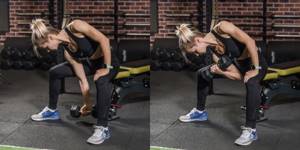
Sit on a bench, take a dumbbell in your hand. Press your shoulder toward your inner thigh. Bend your elbow as you lift the dumbbell and lower it back down. Perform the movement smoothly and under control, try to move your arm in full amplitude: bend to the end and fully extend.
This is an isolated exercise in which only one joint is worked - the elbow. So don't move the rest of your body. If you have to work your core to lift a dumbbell, use a lighter weight or reduce the number of repetitions.
What to buy
Incline Dumbbell Raises

Sit on an incline bench with dumbbells in your hands, press your body to the back, feet to the floor. Lower your arms so that they hang freely down and your elbows are behind your body line. Curl your arms with the dumbbells, then smoothly and under control return to the starting position and repeat.
Raising barbells or dumbbells for biceps
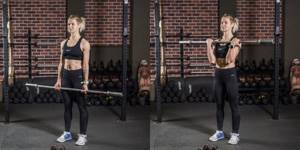
Take the barbell with an underhand grip, bend your elbows and lift it to shoulder level. Lower back down and repeat. Make sure that only your arms move, and the rest of your body remains static: there should be no swinging.
The same exercise can be done with dumbbells. At the extreme point, turn your hands with your fingers towards you.

Barbell row with reverse grip to the waist

Take the barbell with a reverse grip, slightly tilt your body forward, but keep your back straight. Pull the barbell up until it touches your upper abdomen, gently lower it back down and repeat.
Reverse grip pull-ups
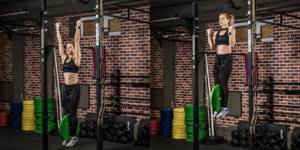
Any pull-up pumps up the biceps, but by turning your arms with your palms facing you, you will load it even more. Grab the horizontal bar with a reverse grip, lower your shoulders, squeeze your shoulder blades together. Pull yourself up until your chin passes the bar. Keep your neck straight, do not extend your chin towards the horizontal bar.
If you don't know how to do pull-ups yet, try two simplified versions: eccentric and inclined, or Australian. You can perform them with a forward or reverse grip. The straight line is a little more difficult, but with it you will quickly learn how to do pull-ups on the horizontal bar without support.
For eccentric pull-ups, jump up and lower down as slowly as possible.
Australian pull-ups are performed on a low horizontal bar. Stretch your body in one line, squeeze your shoulder blades together and pull yourself up until your chest touches the horizontal bar.
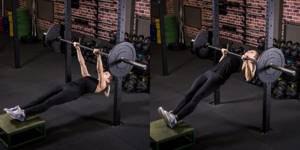
If you only train on the horizontal bar, alternate between different types of pull-ups to give your biceps a good workout.
Exercises at home
For home exercises the following are mainly used:
- removable horizontal bars;
- small dumbbells;
- expanders.
Biceps pull-ups using removable horizontal bars will help you work your biceps, triceps and back. Do not perform the full amplitude, as you may lose muscle tension at the bottom point.
Biceps/triceps curls with small dumbbells are a great option for beginners. The convenience and modest weight of the projectiles will allow you to easily develop the correct technique. The standard number of repetitions is 8–10. If you want to increase your endurance, the 15-25 rep range will help you achieve this.
Wrist pressing movements are performed using “donuts” and spring exercise machines.
Biceps curls, triceps extensions and shoulder rows can be performed with a rubber band machine, one part of which you will fix with your leg, and the other part will perform the exercises. This way you will create the necessary resistance.
This is all quite enough for a good workout at home. Pull-ups and push-ups are suitable here, as well as other classic exercises with your own body weight that use your arms.
What should the training be like?
The main point of performing training to pump up arm muscles is variety and an integrated approach. Limiting yourself to one or two exercises, pumping, for example, biceps, hoping that this will be enough, is strongly not recommended.
You need to perform three or four exercises for both triceps and biceps. The muscles must be engaged and working at full strength. If after exercise there is no pain in the muscles, then the training does not bring the desired effect.
It is not necessary to use all muscle groups in one workout. One day can be devoted to working the pectoral muscles and biceps, and the other to the back and triceps. The main thing to remember is that with underdeveloped muscle mass, results will appear in one and a half or even two months.
You should not focus exclusively on pumping up the muscles in your arms. Otherwise, the body will develop disproportionately. Therefore, no matter which muscle group a bodybuilder is focused on working, the rest should not be ignored either.
One of the most common mistakes many novice bodybuilders make is that they enthusiastically start training and pump their biceps every day. Such an approach not only does not bring results, but also exhausts the athlete.
Constant and regular stress on the muscles, which does not give the desired effect, can lead to reluctance to continue training and a gradual decrease in physical activity. Avoiding such consequences allows you to clearly understand that muscles grow only when training alternates with rest.
If the athlete has a bench press rack at his disposal, it is best to perform deadlifts and rows with a reverse grip, and squats with a barbell. Both isolating and complex exercises, provided regular training and proper execution, give guaranteed results.
And, as mentioned earlier, the main thing is that during the training both small and large muscle groups are involved, that is, one training is devoted to pumping up the triceps and back, and the other to the biceps and chest.
Of course, for some, this approach may not seem the most optimal, but it is supported by personal experience and has demonstrated its effectiveness.
Benefits of strong hands
By exercising, you get a number of advantages compared to untrained people:
- Increased strength. You will be able to lift heavier weights, making it easier to handle everyday heavy loads.
- Endurance. The muscles will begin to acidify more slowly, meaning you will be able to stress them for a longer period of time.
- Appearance. If you are thin, then your volume will increase, and if you have excess fat, lose it by working your arms - they will become sculpted and aesthetically attractive.
Thus, with the help of arm training, you can not only become stronger and more resilient during physical activity, but also increase your attractiveness in the eyes of others.
How to train your hands and fingers?
Many novice athletes, when training their arms, underestimate the role of hand and finger strength. However, by working the extensor muscles, overall arm strength can be achieved.
It is generally customary to focus on the shoulders and forearms. But if you pay attention to training your hand, the strength of your forearm will increase.
Experienced trainers note that developing the fingers and wrists helps to properly hold the weights and increases the impact of strength exercises on the shoulders and forearms. Classes are conducted in several areas.
Compressive force is developed using an expander and a tennis ball. By squeezing and unclenching them, as well as twisting the expander in the form of a figure eight, you can achieve good results in strengthening the hand. There are 3 methods of training your hands with a wrist expander. You can train anywhere several times a day.
Also find out about 10 incredible benefits of a hand expander .
On a note! A thick barbell or bodybar will help improve your holding power. Pinching power in your fingers can be developed by holding the plate away from the barbell with your fingertips.
Features of strength training
Strength training involves working with heavy weights. High repetitions, blocks and isolation exercises are foreign to athletes whose training is aimed at developing strength. Naturally, such exercises as, for example, lat pull-downs in a machine or leg press in a machine may well be present in the training process, but as an additional load and not even in every workout.
The main features of strength training:
- Training aimed at developing strength mainly consists of compound exercises.
- The main feature of such training is to reduce repetitions. Typically, the exercise is performed up to five repetitions.
- The number of approaches, compared to the usual training to increase muscle mass, is greater. There may be 6-8 of them.
- The rest time between approaches also increases and ranges from three to five minutes. The rest period may last longer.
- Also, to achieve the effect, exercises are used to develop explosive strength. It's a push and pull.
- The amount of training to develop strength will depend on the working weight. For example, if the weight is 100 percent of your one-repetition maximum (1RM), then the workout that includes that exercise should be done once a week. If the weight is lower, for example, 80 percent of the one-rep maximum, then training can be done twice a week.
- Such training should not be carried out more than once every four days.
- Also, you should observe the speed of the exercise. It usually goes from medium to low. This is necessary so that the body does not get used to the load.
But aerobic exercise is completely irrelevant in the training mode to increase strength.
Particular attention should be paid to the technique of performing the exercises. Firstly, due to correct execution, the risk of injury is reduced, and secondly, the correct technique increases the innervation of the muscles (creates a larger number of nerve endings), accordingly, we get a powerful and better muscle response in all the aspects we need.
To develop strength, use the ladder technique , in which the weight increases with each subsequent approach, and the last approaches are performed with maximum weight (either 80% of the maximum or 100%).
To “break through” the stop in strength development that all athletes encounter, presses with a pause along the movement may be relevant. For example, when performing a bench press: the bench press and lowering of the bar are performed with fixation at the center of the amplitude.
Additional exercises can also be added, which were already discussed at the beginning, these are exercises in simulators, and work with dumbbells, and other types of exercises.
Diligence and time are the key points of training
There are no difficulties or difficulties in performing training to pump up the biceps and triceps muscles. All exercises are quite simple. To achieve results, you just need not to be lazy and be patient. The main thing is to train not occasionally, but systematically. You need to study strictly according to the established schedule, without missing classes.
The frequency of exercise depends on your body type. Naturally lean athletes need to exercise 4 to 5 times a week and eat heavily. You shouldn't expect quick results. You won't be able to pump up your arms in two weeks of training. You need to be patient and not deviate from your intended goal.
If you are persistent and consistent, do not neglect training, doing 1-2 times a week, your efforts and efforts will not be in vain, and your hands will acquire the coveted definition and become a source of pride.
The best exercises to develop strength
To increase strength, it is not enough to lift heavy weights. The muscular frame must develop comprehensively, since a weak “link” in the muscular structure, for example, the lower back muscles, when lifting a lot of weight on squats, completely deprives you of the opportunity to develop in strength indicators, and also threatens serious injury, so every strength exercise is the exercise that works the maximum number of muscles. But that's not all. To develop strength indicators, it is imperative to pay attention to explosive strength, so jerking techniques cannot be excluded.
Here is a list of great exercises to increase strength:
Best Exercises for Arm Strength
Of these, the best exercises for developing arm strength are: bench press, pull-ups, dips, push-ups, standing barbell press. These are basic exercises that, in addition to the deltoids and shoulder muscles, help strengthen other, larger muscles, such as the back and chest. The fact is that to develop strength, you should not perform isolation exercises like barbell curls or French presses. These are narrowly targeted exercises that hone the shape and relief of a particular muscle, but they directly influence the development of strength to a lesser extent.
Best Exercises for Leg Strength
Such exercises are deadlifts, squats, lunges, jumping jacks. These exercises, more than others, help increase strength, including explosiveness, of all muscles in general and give an anabolic boost by increasing testosterone production. Without these exercises, you should not hope to develop the muscles of the arms or other groups.
Remember, developing strength is a complex method that requires the involvement of more muscles and ligaments in the exercise, the development of not only external muscles, but also deep ones. And this will be facilitated not only by dynamic load, but also by static load - maintaining a position for a certain period of time. As you can see below, the training process is also aimed at developing explosive strength, without which it is sometimes impossible to overcome the stagnation of strength indicators. Read about static exercises here →
Developing strength strengthens muscles and contributes to their shortening due to their constant contraction and overexertion. Therefore, it is important to return the fibers to their normal anatomical state and help improve their flexibility and elasticity. To do this, do not neglect stretching your muscles at the end of your workout.
Shoulder Exercises
The shape of the shoulders is determined by the deltoids. They cover the shoulder joint and are involved in flexion, extension, abduction and adduction of the shoulder.
Standing barbell or dumbbell press
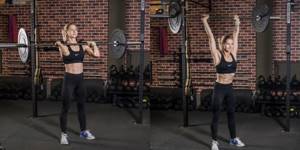
This exercise works both the shoulders and triceps well. Take the barbell to your chest, bring your elbows forward. Press the barbell up and behind your head. Lower to the starting position and repeat.
During the bench press, do not throw your head back, it is better to pull your chin in: this way the barbell will follow the optimal trajectory - straight up.
If you perform the exercise with dumbbells, in the starting position, hold them above your shoulders, and then press up, turning your palms away from you.
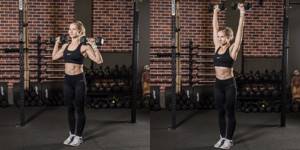
Dumbbell lateral raises
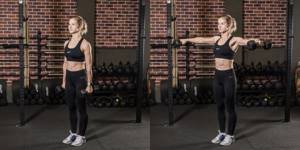
Stand up straight, take dumbbells, turn your arms with your palms facing you - this is the starting position. Bend your elbows slightly and spread your arms out to the sides until they are parallel to the floor. Lower to the starting position and repeat.
Forearm plank twist
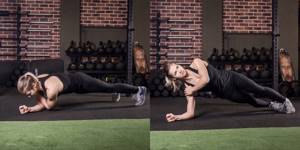
Stand upright lying on your forearms, tense your abs and buttocks, place one palm on the opposite shoulder - this is the starting position. Rotate your torso to the side to move into a side forearm plank. Go back and repeat.
Make sure that in the starting position your shoulder is located above your elbow, do not relax your abdominal muscles - keep your core engaged until the end of the exercise.
Tilt wiring
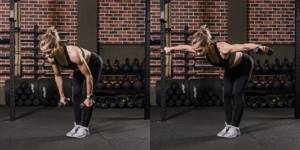
This is an exercise for the posterior deltoid muscles. Take dumbbells in your hands, tilt your body until it is parallel to the floor or slightly higher. Stretch your arms out to the sides and bring them back.
Lifting from the floor using fists

Lie on the floor, spread your arms to the sides, clench your fists. Using your fists on the floor, lift your upper body and lift your shoulder blades off the floor. Try to relax your abs and lift up using your arms only. Hold the position for 1-2 seconds, lower back down and repeat.
Strength training program for men
Much attention should be paid to warming up before performing the exercise. The weight needs to be increased gradually, and the first approaches with an empty bar and small weighting discs should never be ignored. Approaches with working weights performed with unheated muscles guarantee injuries.
As an example, let's take the training process with a three-day interval . It is best to distribute training days at equal intervals - Monday, Friday, Tuesday, Saturday and so on.
There is a training scheme in which the training days follow one another - Monday, Tuesday and Wednesday, after which a four-day phase begins, after which three training sessions are again carried out in a row. The second option is less relevant for beginner athletes, so let's take the first scheme.
Exercises to develop arm muscle strength
Exercises to develop arm muscle strength
Execution technique: take the starting position – lying down, legs together.
From the starting position, perform push-ups. The pace of execution is average. The number of repetitions is 10–20 times in one approach, depending on the level of fitness.
Execution options:
a) fingertip push-ups;
b) push-ups with fists;
c) push-ups with clapping: one clap, two clap;
d) from the starting position, emphasis lying on your fists - push-ups with the transition to the backs of your hands.
Nature of impact: the exercise effectively develops the muscles of the upper shoulder girdle, arms, chest and strengthens the hands.
Important points:
1) during execution, keep your legs straight, your upper body and hips should form one straight line;
2) maintain an average pace of execution, bend your elbows to an angle of 90°;
3) since push-ups on the backs of the hands place a large load on the wrist joint, we recommend that you exclude this exercise at the initial stage of strength development or perform it with maximum caution.
Execution technique: take the starting position - the body is naturally straightened, legs are together, arms are freely lowered along the body, keep your head straight.
From the starting position, perform a push-up and a push-up, return to the starting position and jump up as high as possible. While jumping up, clap your palms above your head. The pace of execution is as fast as possible. The number of repetitions is 5–10 times in one approach.
Nature of the impact: the exercise develops the muscles of the upper shoulder girdle, strengthens the hands and wrists.
Important points:
1) try to maintain the fastest pace of execution;
2) as muscle strength develops, increase the range of motion and the number of approaches.
Execution technique: the exercise is performed in pairs with a partner. Take the starting position - lying down, your partner holds your legs by the ankles.
From the starting position, using different directions - back and forth and diagonally - perform the movement on your hands. The wider your arms are, the higher the load. The pace of execution is fast. Perform the exercise for 10–30 seconds, depending on your level of fitness.
Nature of impact: the exercise effectively strengthens the hands, wrists and develops the muscles of the chest and shoulder girdle.
Important points:
1) control your partner’s actions and ensure that your body maintains balance;
2) as your hands strengthen, increase the amplitude and speed of execution;
3) keep your breathing calm.
Execution technique: the exercise is performed in pairs with a partner. Take the starting position - rest on your hands with your back to the surface. Ask your partner to grab your legs at the ankles.
Exercises for the back of the arms
On the back of the shoulder is a muscle that extends the elbow - the triceps. It comes into play during any movement where you push something away from you or yourself from the floor or wall.
Reverse push-ups on a bench

This exercise is suitable for any level of training. Place your hands on the bench behind your body and lower your shoulders. Bend your elbows, going down until your shoulders are parallel to the floor, and then push yourself up. You can bend your legs at the knees or straighten them. The latter is more difficult.
Dips

Jump onto the bars, lower your shoulders and squeeze your shoulder blades together, stretching your body in one line. Bend your elbows and lower yourself down until your shoulders are parallel to the floor, but not lower, so as not to injure the shoulder joint. Push yourself back up and repeat.
Perform the movement smoothly, without rocking or jerking. If there is not enough load, add weights in the form of a pancake. If, on the contrary, the exercise is too difficult, try performing it using an expander band. To do this, hang it on the bars, put your feet on it and do push-ups. The elastic band will push you upward, relieving some of the load.
Triceps extension with dumbbell
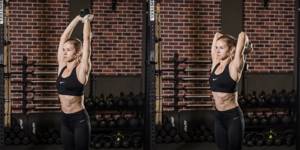
Stand up straight, grab a dumbbell with both hands and lift it above your head. Bend your elbows and lower the dumbbell behind your head. Lift back up and repeat.
Bent over arm extension
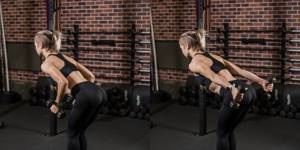
Take dumbbells in your hands, bend your knees slightly and tilt your body forward with a straight back. Bend your elbows at right angles, keeping them close to your body. Extend your arms with dumbbells and return to the starting position.
Diamond push-ups
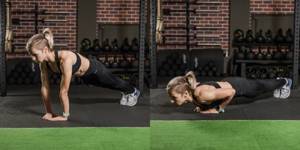
This type of push-up works the triceps the most due to the narrow placement of the arms. Place your hands so that your index fingers and thumbs are connected. Lower your shoulders, extend your body in one line from shoulders to feet.
Lower yourself down and push yourself up, keeping your body straight. Try not to bend in the lower back; to do this, tense your abs.
